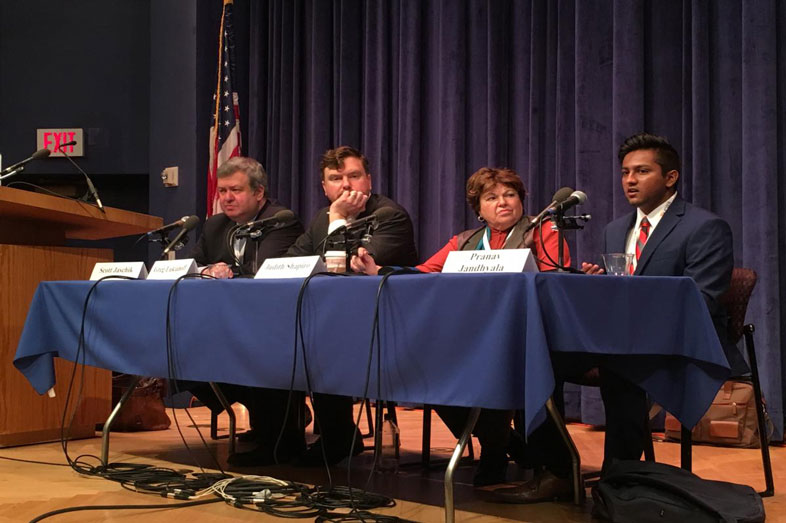
How Much Freedom of Speech Is Welcome on College Campuses?
Free speech has once again become a highly charged issue on college campuses.

Free speech has once again become a highly charged issue on college campuses.
Free speech has once again become a highly charged issue on college campuses, where protests frequently have interrupted, and in some cases halted, appearances by polarizing speakers.
At a lively panel last week during the Education Writers Association’s annual conference in Washington, D.C., free speech advocates and a student leader from the University of California, Berkeley, debated who was at fault and what could be done.
Alt-right provocateur Milo Yiannopoulos’s winter tour of colleges across the country drew protesters from off and on campuses and sparked violent clashes, including one in which a man was shot in Seattle. At Berkeley — home of the free speech movement 50 years ago — university officials canceled his scheduled appearance in February and later pulled the plug on a scheduled April visit by conservative commentator Ann Coulter, citing safety concerns.
In March, a protest at Middlebury College left injured both the speaker, controversial social scientist Charles Murray, and a professor who wasn’t his supporter.
The way these altercations on campus were characterized by the media during the growing national public debate on First Amendment rights at colleges frustrated many students.
“This whole issue of free speech is a lot more nuanced than what it appears to be in a single headline or what it appears to be on the surface,” Pranav Jandhyala, who co-founded the nonpartisan campus group BridgeUSA at Berkeley, said during last Thursday’s panel discussion. “It’s not just about the people who invited the speaker and the people who are trying to silence her.”
BridgeUSA, Jandhyala explained, was formed earlier this year after university leaders at the last minute canceled Yiannopoulos’s talk — an appearance the university had been defending, citing its commitment to tolerance. The decision was made after protests on the day Yiannopoulos was scheduled to appear caused about $100,000 in damage. Those protests had been escalated by what appeared to be a group of outside protesters who were not students.
Violence replaced conversation that day, Jandhyala said, and his student group set out to create more events where students could debate and challenge different views without fear of violence. They asked liberal student groups to pick a speaker to come to campus and debate with students from all sides. They did the same for the conservative students, who picked Ann Coulter.
“We wanted to invite her because if you viewed her as hateful and you viewed her as inflammatory and nothing of value, then why don’t you go ahead and actually challenge her?” he said. “We were creating this larger Q&A with her that would essentially be liberal Berkeley students challenging Ann Coulter on the issue of illegal immigration.”
Jandhyala and fellow panelists, moderated by Scott Jaschik, editor of Inside Higher Ed, discussed a recent Gallup survey that found that when they were asked if they believed in free speech, a majority of students across all political, racial and ethnic groups said yes. But when asked if they favored college policies that banned hate speech, an overwhelming majority of students also said yes, without seeing a contradiction in the two answers.
Greg Lukianoff, president and CEO of the Foundation for Individual Rights in Education (FIRE), which promotes free speech and due process rights at universities, said the narrative so often gets oversimplified to “the cliche ‘PC run amok.’” Lukianoff said not all free speech issues are political.
“Last year, the case I was the most upset about was the case at Northern Michigan University, where students who took advantage of the counseling services there were then sent scary letters saying ‘Listen, if you talk to any of your friends about thoughts of self-harm, you will be punished,’” he said. “This is telling people who are either depressed or anxious that they’re a burden on their friends and that they should isolate themselves. But somehow, that does not get the same coverage.”
Judith Shapiro, the former president of Barnard College who now heads The Teagle Foundation, which works to strengthen liberal arts education, said the heart of the debate really may be “less an absence of freedom of speech and more an absence of quality of speech.”
“The institution has the right to say: OK, is it worth it? … Who should we be listening to and engaging with? Who, even if you disagree, could you actually learn something from?” she said, which led to a lighthearted discussion about the relative cultural value of a campus hosting Snooki from the reality show “Jersey Shore” or Nobel Prize-winning novelist Toni Morrison.
“As soon as you actually start trying to evaluate people on the basis of the quality of the discourse that they’re bringing to campus, that’s when a lot of people’s biases really present themselves,” Lukianoff said.
This national fight over where to draw the line, however complicated, needs to focus more on emphasizing the power of engagement than on “protecting free speech for free speech’s sake,” Jandhyala said.
“It’s about creating an environment where you’re willing to listen to all different perspectives, form your own from listening … and also be willing to challenge and debate with others and engage in discussion with the people that you disagree with,” he said. “That is the driving purpose of free speech.”
Your post will be on the website shortly.
We will get back to you shortly